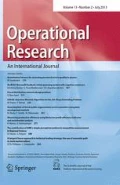Abstract
This paper presents water wave optimization (WWO) algorithm to solve the optimal reactive power dispatch (ORPD) problem with the continuous and discrete control variables in power system. The ORPD problem is defined as a complex, discrete, constrained nonlinear combinatorial optimization problem. The WWO algorithm is utilized to find the optimized values of control variables such as generator voltages, tap positions of tap changing transformers and the amount of reactive compensation devices to achieve minimized value of active power losses. The WWO algorithm not only effectively avoids the shortcomings of local search and poor calculation accuracy, but also accelerates the convergence rate to find the global optimal solution. The WWO algorithm is implemented on standard IEEE 30-bus power system that is to verify the effectiveness and feasibility of the WWO algorithm to tackle with the ORPD problem. Compared with other algorithms, the WWO algorithm can find the set of the optimal solutions of control variables. The simulation experiment indicates that the WWO algorithm has better overall performance to reduce the real power losses.






Similar content being viewed by others
References
Alsac O, Stott B (1974) Optimal load flow with steady-state security. IEEE Trans Power Appar Syst PAS-93 3:745–751
Askarzadeh A (2016) A novel metaheuristic method for solving constrained engineering optimization problems: crow search algorithm. Comput Struct 169:1–12
Attia A-F, Al-Turki YA, Abusorrah AM (2012) Optimal power flow using adapted genetic algorithm with adjusting population size. Electr Power Comp Syst 40(11):1285–1299
Bjelogrlic M et al (1990) Application of Newton’s optimal power flow in voltage/reactive power control. IEEE Trans Power Syst 5(4):1447–1454
Deeb N, Shahidehpur SM (1990) Linear reactive power optimization in a large power network using the decomposition approach. IEEE Trans Power Syst 5(2):428–438
Duman S et al (2012) Optimal reactive power dispatch using a gravitational search algorithm. Gener Transm Distrib IET6 6:563–576
Garcia S, Molina D et al (2008) A study on the use of nonparametric tests for analyzing the evolutionary algorithms’ behaviour: a case study on the CEC’2005 special session on real parameter optimization. J Heuristics 15:617
Ghasemi M, Ghanbarian MM, Ghavidel S et al (2014) Modified teaching learning algorithm and double differential evolution algorithm for optimal reactive power dispatch problem: a comparative study. Inf Sci 278(278):231–249
Ghasemi M, Taghizadeh M, Ghavidel S et al (2015) Solving optimal reactive power dispatch problem using a novel teaching–learning-based optimization algorithm. Eng Appl Artif Intell 39:100–108
Ghasemi M, Taghizadeh M, Ghavidel S et al (2016) Colonial competitive differential evolution: an experimental study for optimal economic load dispatch. Appl Soft Comput 40:342–363
Grudinin N (1998) Reactive power optimization using successive quadratic programming method. IEEE Trans Power Syst 13(4):1219–1225
Kenarangui R, Seifi A (1994) Fuzzy optimal reactive power control. Electr Power Syst Res 30(1):47–55
Kennedy J, Eberhart R (1995) Particle swarm optimization. In: Proceedings of the IEEE international conference on neural networks, Perth, Australia, vol IV, pp 1942–1948
Khazali AH, Kalantar M (2011) Optimal reactive power dispatch based on harmony search algorithm. Int J Electr Power Energy Syst 33(3):684–692
Lai LL et al. (2005) Swarm intelligence for optimal reactive power dispatch. In: Transmission and distribution conference and exhibition: Asia and Pacific, 2005 IEEE/PES IEEE pp 1–5
Lee KY, Park YM, Ortiz JL (1985a) A united approach to optimal real and reactive power dispatch. IEEE Trans Power Appar Syst PAS-104 5:1147–1153
Lee KY, Park YM, Oritz JL (1985b) A united approach to optimal real and reactive power dispatch. IEEE Trans Power Syst 104(5):1147–1153
Mandal B, Roy PK (2013) Optimal reactive power dispatch using quasi-oppositional teaching learning based optimization. Int J Electr Power Energy Syst 53(1):123–134
Mirjalili S (2016) SCA: a sine cosine algorithm for solving optimization problems. Knowl-Based Syst 96:120–133
Momoh JA, Guo SX, Ogbuobiri EC, Adapa R (1994) The quadratic interior point method solving power system optimization problems. IEEE Trans Power Syst 9(3):1327–1336
Mouassa S, Bouktir T (2016) Artificial bee colony algorithm for discrete optimal reactive power dispatch. In: International conference on industrial engineering and systems management IEEE
Mouassa S, Bouktir T, Salhi A (2017) Ant lion optimizer for solving optimal reactive power dispatch problem in power systems. Eng Sci Technol Int J 20:885–895
Shaw B, Mukherjee V, Ghoshal SP (2014) Solution of reactive power dispatch of power systems by an opposition-based gravitational search algorithm. Int J Electr Power Energy Syst 55(1):29–40
Sulaiman MH et al (2015) Using the gray wolf optimizer for solving optimal reactive power dispatch problem. Appl Soft Comput 32(C):286–292
Varadarajan M, Swarupa KS (2008) Differential evolution approach for optimal reactive power dispatch. Appl Soft Comput 8(4):1549–1561
Wilcoxon F (1944) Individual comparisons by ranking methods. Biom Bull Biom 1(6):112–114
Wu YC, Debs AS, Marsten RE (1994) A direct nonlinear predictor–corrector primal–dual interior point algorithm for optimal power flows. IEEE Trans Power Syst 9(2):876–883
Yang XS (2012) Flower pollination algorithm for global optimization. In: Proceedings of the unconventional computation and natural computation, lecture notes computer science, vol 7445, pp 240–249
Yang XS, He X (2013) Bat algorithm: literature review and applications. Int J Bio-Inspired Comput 5(3):141–149
Zheng YJ (2015) Water wave optimization: a new nature-inspired metaheuristic. Comput Oper Res 55:1–11
Acknowledgements
This work was supported by the National Science Foundation of China under Grant Nos. 61463007 and Project of the Guangxi Natural Science Foundation under Grant No. 2016GXNSFAA380264.
Author information
Authors and Affiliations
Corresponding author
Rights and permissions
About this article
Cite this article
Zhou, Y., Zhang, J., Yang, X. et al. Optimal reactive power dispatch using water wave optimization algorithm. Oper Res Int J 20, 2537–2553 (2020). https://doi.org/10.1007/s12351-018-0420-3
Received:
Revised:
Accepted:
Published:
Issue Date:
DOI: https://doi.org/10.1007/s12351-018-0420-3




